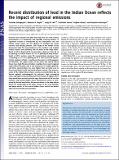Recent distribution of lead in the Indian Ocean reflects the impact of regional emissions
Author(s)
Lee, Jong-Mi; Gamo, Toshitaka; Obata, Hajime; Norisuye, Kazuhiro; Echegoyen Sanz, Yolanda; Boyle, Edward A; ... Show more Show less
DownloadEchegoyen-2014-Recent distribution.pdf (994.5Kb)
PUBLISHER_POLICY
Publisher Policy
Article is made available in accordance with the publisher's policy and may be subject to US copyright law. Please refer to the publisher's site for terms of use.
Terms of use
Metadata
Show full item recordAbstract
Humans have injected lead (Pb) massively into the earth surface environment in a temporally and spatially evolving pattern. A significant fraction is transported by the atmosphere into the surface ocean where we can observe its transport by ocean currents and sinking particles. This study of the Indian Ocean documents high Pb concentrations in the northern and tropical surface waters and extremely low Pb levels in the deep water. North of 20°S, dissolved Pb concentrations decrease from 42 to 82 pmol/kg in surface waters to 1.5–3.3 pmol/kg in deep waters. South of 20°S, surface water Pb concentrations decrease from 21 pmol/kg at 31°S to 7 pmol/kg at 62°S. This surface Pb concentration gradient reflects a southward decrease in anthropogenic Pb emissions. The upper waters of the north and central Indian Ocean have high Pb concentrations resulting from recent regional rapid industrialization and a late phase-out of leaded gasoline, and these concentrations are now higher than currently seen in the central North Pacific and North Atlantic oceans. The Antarctic sector of the Indian Ocean shows very low concentrations due to limited regional anthropogenic Pb emissions, high scavenging rates, and rapid vertical mixing, but Pb still occurs at higher levels than would have existed centuries ago. Penetration of Pb into the northern and central Indian Ocean thermocline waters is minimized by limited ventilation. Pb concentrations in the deep Indian Ocean are comparable to the other oceans at the same latitude, and deep waters of the central Indian Ocean match the lowest observed oceanic Pb concentrations.
Date issued
2014-10Department
Massachusetts Institute of Technology. Department of Earth, Atmospheric, and Planetary Sciences; Woods Hole Oceanographic InstitutionJournal
Proceedings of the National Academy of Sciences of the United States of America
Publisher
National Academy of Sciences (U.S.)
Citation
Echegoyen, Y., E. A. Boyle, J.-M. Lee, T. Gamo, H. Obata, and K. Norisuye. “Recent Distribution of Lead in the Indian Ocean Reflects the Impact of Regional Emissions.” Proceedings of the National Academy of Sciences 111, no. 43 (October 13, 2014): 15328–15331.
Version: Final published version
ISSN
0027-8424
1091-6490